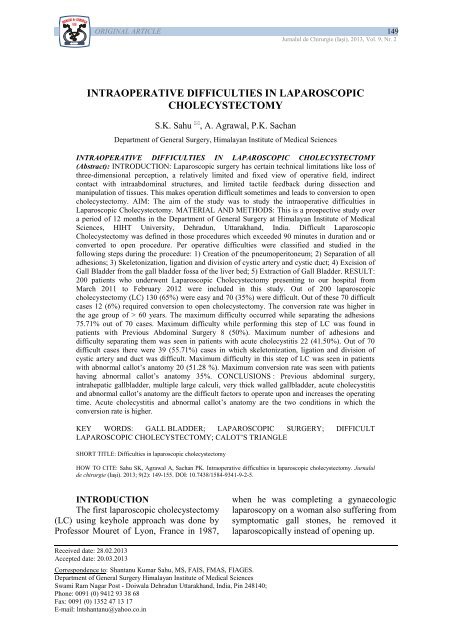PDF (5 MB) - Jurnalul de Chirurgie
PDF (5 MB) - Jurnalul de Chirurgie
PDF (5 MB) - Jurnalul de Chirurgie
You also want an ePaper? Increase the reach of your titles
YUMPU automatically turns print PDFs into web optimized ePapers that Google loves.
ORIGINAL ARTICLE 149<strong>Jurnalul</strong> <strong>de</strong> <strong>Chirurgie</strong> (Iaşi), 2013, Vol. 9, Nr. 2INTRAOPERATIVE DIFFICULTIES IN LAPAROSCOPICCHOLECYSTECTOMYS.K. Sahu , A. Agrawal, P.K. SachanDepartment of General Surgery, Himalayan Institute of Medical SciencesINTRAOPERATIVE DIFFICULTIES IN LAPAROSCOPIC CHOLECYSTECTOMY(Abstract): INTRODUCTION: Laparoscopic surgery has certain technical limitations like loss ofthree-dimensional perception, a relatively limited and fixed view of operative field, indirectcontact with intraabdominal structures, and limited tactile feedback during dissection andmanipulation of tissues. This makes operation difficult sometimes and leads to conversion to opencholecystectomy. AIM: The aim of the study was to study the intraoperative difficulties inLaparoscopic Cholecystectomy. MATERIAL AND METHODS: This is a prospective study overa period of 12 months in the Department of General Surgery at Himalayan Institute of MedicalSciences, HIHT University, Dehradun, Uttarakhand, India. Difficult LaparoscopicCholecystectomy was <strong>de</strong>fined in those procedures which excee<strong>de</strong>d 90 minutes in duration and orconverted to open procedure. Per operative difficulties were classified and studied in thefollowing steps during the procedure: 1) Creation of the pneumoperitoneum; 2) Separation of alladhesions; 3) Skeletonization, ligation and division of cystic artery and cystic duct; 4) Excision ofGall Blad<strong>de</strong>r from the gall blad<strong>de</strong>r fossa of the liver bed; 5) Extraction of Gall Blad<strong>de</strong>r. RESULT:200 patients who un<strong>de</strong>rwent Laparoscopic Cholecystectomy presenting to our hospital fromMarch 2011 to February 2012 were inclu<strong>de</strong>d in this study. Out of 200 laparoscopiccholecystectomy (LC) 130 (65%) were easy and 70 (35%) were difficult. Out of these 70 difficultcases 12 (6%) required conversion to open cholecystectomy. The conversion rate was higher inthe age group of > 60 years. The maximum difficulty occurred while separating the adhesions75.71% out of 70 cases. Maximum difficulty while performing this step of LC was found inpatients with Previous Abdominal Surgery 8 (50%). Maximum number of adhesions anddifficulty separating them was seen in patients with acute cholecystitis 22 (41.50%). Out of 70difficult cases there were 39 (55.71%) cases in which skeletonization, ligation and division ofcystic artery and duct was difficult. Maximum difficulty in this step of LC was seen in patientswith abnormal callot’s anatomy 20 (51.28 %). Maximum conversion rate was seen with patientshaving abnormal callot’s anatomy 35%. CONCLUSIONS : Previous abdominal surgery,intrahepatic gallblad<strong>de</strong>r, multiple large calculi, very thick walled gallblad<strong>de</strong>r, acute cholecystitisand abnormal callot’s anatomy are the difficult factors to operate upon and increases the operatingtime. Acute cholecystitis and abnormal callot’s anatomy are the two conditions in which theconversion rate is higher.KEY WORDS: GALL BLADDER; LAPAROSCOPIC SURGERY; DIFFICULTLAPAROSCOPIC CHOLECYSTECTOMY; CALOT’S TRIANGLESHORT TITLE: Difficulties in laparoscopic cholecystectomyHOW TO CITE: Sahu SK, Agrawal A, Sachan PK. Intraoperative difficulties in laparoscopic cholecystectomy. <strong>Jurnalul</strong><strong>de</strong> chirurgie (Iaşi). 2013; 9(2): 149-155. DOI: 10.7438/1584-9341-9-2-5.INTRODUCTIONThe first laparoscopic cholecystectomy(LC) using keyhole approach was done byProfessor Mouret of Lyon, France in 1987,when he was completing a gynaecologiclaparoscopy on a woman also suffering fromsymptomatic gall stones, he removed itlaparoscopically instead of opening up.Received date: 28.02.2013Accepted date: 20.03.2013Correspon<strong>de</strong>nce to: Shantanu Kumar Sahu, MS, FAIS, FMAS, FIAGES.Department of General Surgery Himalayan Institute of Medical SciencesSwami Ram Nagar Post - Doiwala Dehradun Uttarakhand, India, Pin 248140;Phone: 0091 (0) 9412 93 38 68Fax: 0091 (0) 1352 47 13 17E-mail: lntshantanu@yahoo.co.in
















